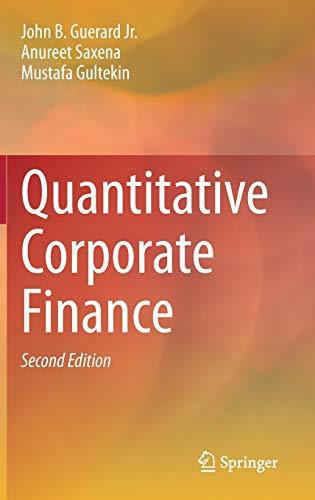Question
Several methods can be used to compute the intrinsic value of a share of a companys common stock. One method uses the free cash flow
Several methods can be used to compute the intrinsic value of a share of a companys common stock. One method uses the free cash flow (FCF) valuation model, while the another method uses the dividend discount model.
The FCF valuation model computes a firms valuealso called its valueas the sum of the value of its operating activities (Vopop) and the value of firms nonoperating , where:
| From a managers perspective, an important difference between a firms operating assets and its nonoperating assets is that its assets are more strongly influenced by market forces, including interest rates, than by managers decisions and actions. | |
| The companys intrinsic value can be computed and expressed for the organization as a whole, for a component of the company, or on a per-share basis. The per-share intrinsic value of the firms equity is calculated by dividing the intrinsic value of the equity by the number of . |
Which of the following statements about the FCF valuation model are true? Check all that apply.
The model has limited applicability because it fails to adjust for a firms riskinessparticularly that created by managers decisions to use debt in the firms capital structure, or decisions regarding the payment of cash dividends.
A companys FCFs are a function of how effectively managers control the firms costs, manage its operating and nonoperating assets, and generate sales revenues.
The FCF valuation model recognizes that a firms value is a function of its riskincluding its use of debt and equity financing and the markets in which it operates.
The model is useful because it provides its decision-makers with insights into the quality of their decision-making, as measured by the intrinsic value of their company.
Consider the case of Soggy Otter Manufacturing:
Next year, Soggy Otter is expected to earn an EBIT of $11,000,000, and to pay a federal-plus-state tax rate of 35%. It also expects to make $2,750,000 in new capital expenditures to support this level of business activity, as well as $10,000 in additional net operating working capital (NOWC).
Given these expectations, it is reasonable to conclude that next year Soggy Otter will generate an annual free cash flow (FCF) of (rounded to the nearest whole dollar).
Next, based on your estimate of Soggy Otters next years FCF and making the stated assumptions, complete the following table:
| Soggy Otter can sustain this annual FCF forever, | |
| the company has a weighted average cost of capital of 10.62%, | |
| the company does not currently own any marketable securities, | |
| there are 15,000 shares of Soggy Otter outstanding | |
| the companys value of debt is 45% of its total entity value, and | |
| the companys value of preferred shares is 25% of its total entity value. |
| Attributes of Soggy Otter | Value |
|---|---|
| Total Entity Value | |
| Value of Common Equity | |
| Intrinsic value (per share) |
Step by Step Solution
There are 3 Steps involved in it
Step: 1

Get Instant Access to Expert-Tailored Solutions
See step-by-step solutions with expert insights and AI powered tools for academic success
Step: 2

Step: 3

Ace Your Homework with AI
Get the answers you need in no time with our AI-driven, step-by-step assistance
Get Started


